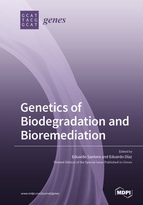Genetics of Biodegradation and Bioremediation
A special issue of Genes (ISSN 2073-4425). This special issue belongs to the section "Microbial Genetics and Genomics".
Deadline for manuscript submissions: closed (31 March 2019) | Viewed by 64869
Special Issue Editors
Interests: biodegradation organic contaminants; catabolic pathways characterization; gene expression regulation in bacteria; nitrogen metabolism control; carbon catabolite repression; design of expression systems in bacteria
Special Issue Information
Dear Colleagues,
Industrial activity has resulted in the production of huge amounts of compounds, many of them xenobiotics, which are very persistent in nature because of their stable chemical structure, low biodegradability, or toxicity, and accumulate to concentrations that affect the environment. However, several bacteria have evolved to metabolize these contaminants, in many cases using them as nutrient or energy sources.
Many different biodegradation pathways have already been characterised, and the phylogenetic relationships among biodegradation genes within the different types of pathways have been studied. However, new biodegrading activities and their coding genes are continuously being reported, including those involved in the biodegradation of emerging contaminants or those generally regarded as non-biodegradable. New biodegradation pathways can be assembled in a strain or a bacterial consortium by recruiting biodegradation genes from different origins through horizontal gene transfer. Gene regulation is also an important issue for the efficient biodegradation of contaminants. Specific induction by the substrate and over-imposed global regulatory networks adjust the expression of the biodegradation genes to the bacterial physiological needs. The abundance and diversity of biodegradation genes, analysed by either genomic or metagenomic approaches, is an indicator of the biodegradation potential of a niche and is used together with contaminant biosensors to follow the progress of natural or programmed bioremediation programs.
This Special issue will cover the genetic, genomic or metagenomic identification and characterisation of biodegradation genes, gene products and their host strains, as long as gene regulation, transport, monitoring in the environment or utilisation of biodegradation genes or their regulatory systems as reporters, biosensors or expression platforms, either in oxic, anoxic or extreme environments. We cordially invite researchers working in these areas to contribute with original research or review papers.
Prof. Eduardo Santero
Prof. Eduardo Díaz
Guest Editors
Manuscript Submission Information
Manuscripts should be submitted online at www.mdpi.com by registering and logging in to this website. Once you are registered, click here to go to the submission form. Manuscripts can be submitted until the deadline. All submissions that pass pre-check are peer-reviewed. Accepted papers will be published continuously in the journal (as soon as accepted) and will be listed together on the special issue website. Research articles, review articles as well as short communications are invited. For planned papers, a title and short abstract (about 100 words) can be sent to the Editorial Office for announcement on this website.
Submitted manuscripts should not have been published previously, nor be under consideration for publication elsewhere (except conference proceedings papers). All manuscripts are thoroughly refereed through a single-blind peer-review process. A guide for authors and other relevant information for submission of manuscripts is available on the Instructions for Authors page. Genes is an international peer-reviewed open access monthly journal published by MDPI.
Please visit the Instructions for Authors page before submitting a manuscript. The Article Processing Charge (APC) for publication in this open access journal is 2600 CHF (Swiss Francs). Submitted papers should be well formatted and use good English. Authors may use MDPI's English editing service prior to publication or during author revisions.
Keywords
- Biodegradation
- Bioremediation
- Catabolic pathway
- Mobile DNA
- Anaerobic biodegradation
- Gene regulation
- Transport
- Regulatory circuits
- Biomonitoring








